(Listen to the radio version here.)
This morning, when I was working at my desk, I suddenly noticed that one of my chickadees has a badly crossed bill. It obviously has trouble preening—its breast feathers are a mess—and it’s presumably having difficulty eating. I saw it just once and clicked a few photos before it flew off.
For many years, I was in the habit of hand-feeding my chickadees from my home office window. Some tapped at the window to get my attention.
Chickadees can recognize individual humans, and it’s only human to imagine that they like us and consider us friends. This may be true, but it’s an unprovable assumption and the chickadees aren’t talking. I’m pretty certain that if they don’t consider us friends, some do at least think of us as reliable waitstaff.
But in April 2014, I forged an unusually intimate friendship with one individual chickadee. I was out of live mealworms on April 16 when I saw a chickadee flitting about at the window, clearly expecting a treat. I didn’t have a chance to get to the store to buy any till late the next day, but on April 18, the moment I cracked open the window, there he was. And distressingly, the poor thing had an overgrown, badly deformed beak. No wonder he wanted soft live mealworms—no way could he peck holes into sunflower seed shells to get the kernels out with his bill like that.
He was suffering from what’s called avian keratin disorder (AKD), which is characterized by dramatic beak deformities such as elongation, crossing, and curvature, making preening and feeding difficult or impossible, so birds with this condition can suffer high rates of mortality. People in south-central Alaska started documenting thousands of chickadees with AKD during the 1990s, and over the next decade it spread into Canada and the Pacific Northwest. By 2014 when my own chickadee was dealing with it, AKD had been reported in several species throughout the lower forty-eight states—mostly chickadees but also raptors, woodpeckers, corvids, and nuthatches.
My little chickadee stuck with me that entire spring, coming several times every day and often sitting in my hand as he ate four or five mealworms. He’d bring the upper bill tip perpendicular to the side of the mealworm and curl it underneath to grasp it in the middle, the crown of his head often softly pressing against my finger or hand for a moment. To eat it he’d brace it confidingly against my hand to take little bites—a yucky, goopy process that I’d never have tolerated except—well, no way could I violate the little guy’s trust.
One morning in May, I noticed that the elongated bill tip seemed to have snapped off. It was squared off for a couple of days, but he apparently pecked with it until he’d whittled the tip to a respectable point again. About that time, I noticed that a chickadee coming to my hand for mealworms had a deformed right foot, the three front toes missing.
That chickadee seemed so unusually tame in my hand that suddenly I wondered—could it be the same one? Sure enough—I’d been so laser-focused on the deformed bill that I hadn’t even noticed the chickadee’s foot, but when I went through all my photos of him, if the foot was visible, it was missing the three front toes.
Chickadees pair off early enough in spring that this guy didn’t have a chance of attracting a mate by the time he looked presentable, though he gave it the old college try—I saw him singing several times. He came to my window on and off through the summer and the next winter, though now that his bill was pretty normal, he wasn’t as dependent on my food offerings.
The next spring—that is, 2015—he disappeared. Well, he didn’t actually disappear—he just stopped showing up in my yard, and I discovered why on June 10 when my neighbor called and told me she had a chickadee nest in her old apple tree. I went over, and what to my wondering eyes should appear but my little guy, missing toes and all, coming into the nest cavity with food.
I went by the next morning, which just happened to be the day the babies fledged. Yep, this little chickadee with two huge strikes against him successfully attracted a mate and they raised a minimum of 5 babies together.
That was the last I saw of him. Even if he felt as grateful to me as I felt toward a very kind nurse named Marcus who helped after my mastectomy, my chickadee and I both knew when it was time to move on toward the rest of our lives.
What caused the deformed bill? As with any novel disease, it took a lot of time and teamwork for scientists to tease that out. Researchers considered contaminants, nutritional deficiencies, disease, parasites, blunt trauma, and genetic abnormalities. Then in 2016, a team of researchers from the California Academy of Sciences, University of California San Francisco, and the USGS used new technology to identify a novel virus, the Poecivirus (Poecile being the Black-capped Chickadee’s genus name), that seemed to be linked to AKD. Following that finding, researchers tested 28 birds with bill deformities and 96 without deformities. One hundred percent of the birds with deformities had the Poecivirus while only 9.4 percent of the birds with healthy bills had the virus. (FeederWatch article about this and also USGS webpage about the research.)
Interestingly, one of the scientists who did this work, Caroline Van Hemert, needed time to decompress after doing all this heartbreaking research, so she and her husband took a 4,000-mile journey, entirely on their own power, into the Alaskan wilderness. She wrote a gripping, award-winning memoir of the trip, The Sun Is a Compass, published in 2019.1
I haven’t thought or read much about AKD in recent years, and haven’t seen another afflicted chickadee since my 2014-15 bird, until the one showed up today. I’m hoping against hope that this one isn’t evidence of another eruption of AKD. I’m leaving for Hawaii in 6 days and feeling terribly sad that I won’t be able to minister to this one the way I did to that other chickadee a decade ago. I hope there’s a kind soul somewhere nearby who will help this one along until, with luck, the bill tips break off.
I interviewed Caroline Van Hemert about her book and her chickadee work for several blogposts and radio programs in 2019:





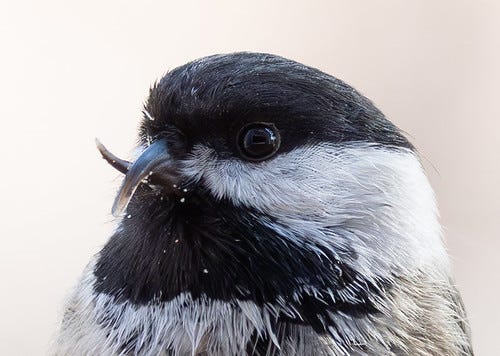
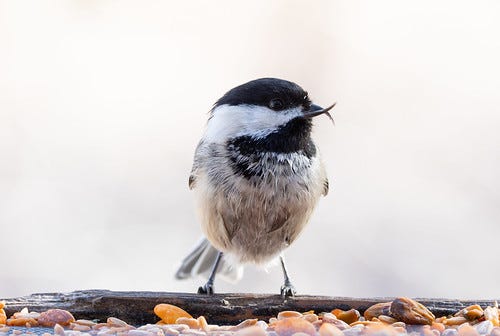
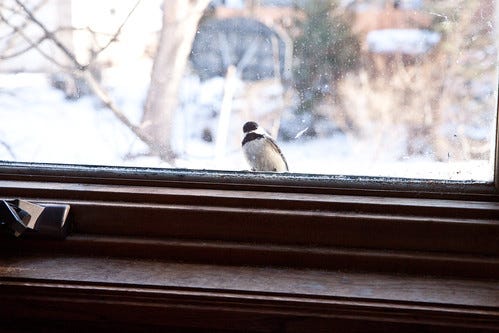
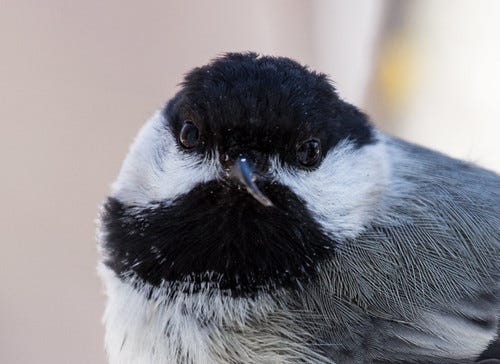
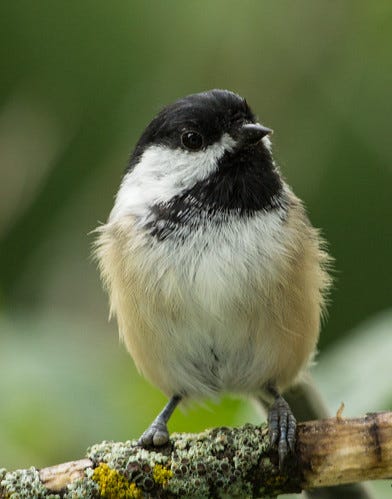
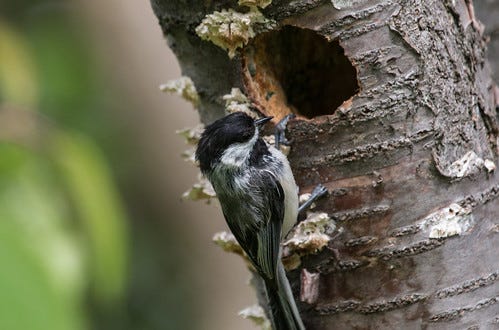
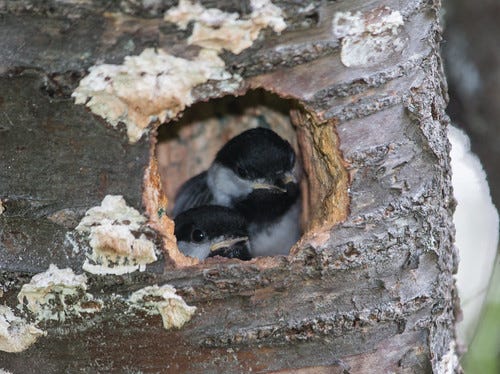
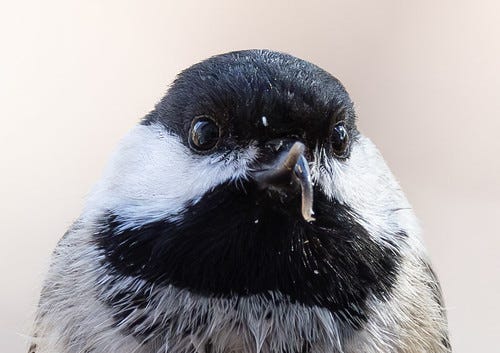
My sister and I have been feeding a crow who had a nasty piece of hard plastic tubing caught on his/her beak. That was bad enough, but the beak must have rotted under the yellow tube because one day the lower beak broke in half. We were so worried. It was autumn and winter was fast coming on. I made the crow broth and nutgruel with mealworms and bits of suet and every day the food was gone. (His buddy would wait until he had finished tilting his head to the side and dipping out his worms, then would come and eat his share.) Two years after the tube appeared, they still come back every day and he is eating more normally.